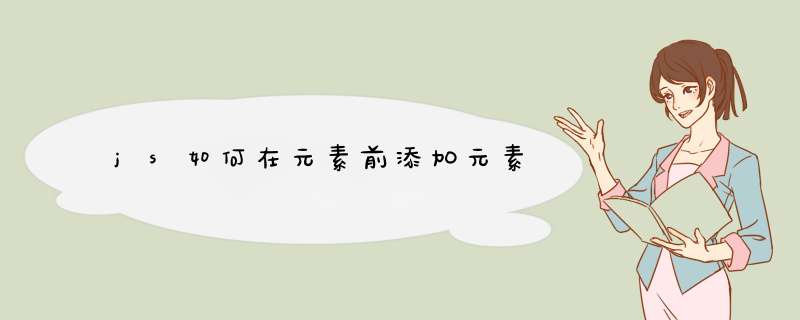
运行页面 1)上一步保存完成后,双击文件即可使用默认浏览器运行页面2)如果想使用指定浏览器运行,右键文件,选择【打开方式】->挑选任一已经安装的浏览器即可
原生JS方式,详细代码与注释 主要使用的js方法: 父元素.insertBefore(新元素, 目标元素)
原生JS方式,运行效果如下 Jquery方式,必须要引入jquery文件才能使用,此处将jquery下载下来放到Content文件夹中,新的目录结构如下-- Content-- jquery-1.11.3.min.js-- JsTest.html
Jquery方式,详细代码与相关注释见截图 主要使用的jquery方法:before(html文本内容即可)
Jquery方式,运行效果如下 JS JQUERY
一、after()和before()方法的区别after()——其方法是将方法里面的参数添加到jquery对象后面去;
如:A.after(B)的意思是将B放到A后面去;
before()——其方法是将方法里面的参数添加到jquery对象前面去。
如:A.before(B)的意思是将A放到B前面去;
二、insertAfter()和insertBefore()的方法的区别
其实是将元素对调位置;
可以是页面上已有元素;也可以是动态添加进来的元素。
如:A.insertAfter(B)即将A元素调换到B元素后面;
如<span>CC</span><p>HELLO</p>使用$("span").insertAfter($("p"))后,就变为<p>HELLO</p><span>CC</span>了。两者位置调换了
三、append()和appendTo()方法的区别
append()——其方法是将方法里面的参数添加到jquery对象中来;
如:A.append(B)的意思是将B放到A中来,后面追加,A的子元素的最后一个位置;
appendTo()——其方法是将jquery对象添加到appendTo指定的参数中去。
如:A.appendTo(B)的意思是将A放到B中去,后面追加,B的子元素的最后一个位置;
四、prepend()和prependTo()方法的区别
append()——其方法是将方法里面的参数添加到jquery对象中来;
如:A.append(B)的意思是将B放到A中来,插入到A的子元素的第一个位置;
appendTo()——其方法是将jquery对象添加到appendTo指定的参数中去。
如:A.appendTo(B)的意思是将A放到B中去,插入到B的子元素的第一个位置;
例子
1、insert局部方法
/**
* 在父级元素上 *** 作DOM
* @param {Object} parent 父级元素,可以是element,也可以是Yquery对象
* @param {String} position 位置: beforebegin/afterbegin/beforeend/afterend
* @param {*} any 任何:string/text/object
* @param {Number} index 序号,如果大于0则复制节点
* @return {Undefined}
* @version 1.0
* 2013年12月2日17:08:26
*/
function _insert(parent, position, any, index) {
if ($.isFunction(any)) {
any = any.call(parent)
}
// 字符串
if ($.isString(any)) {
if (regTag.test(any)) {
parent.insertAdjacentHTML(position, any)
} else {
parent.insertAdjacentText(position, any)
}
}
// 数字
else if ($.isNumber(any)) {
parent.insertAdjacentText(position, any)
}
// 元素
else if ($.isElement(any)) {
parent.insertAdjacentElement(position, index >0 ? any.cloneNode(!0) : any)
}
// Yquery
else if (_isYquery(any)) {
any.each(function() {
_insert(parent, position, this)
})
}
}
2、append、prepend、before、after
$.fn = {
/**
* 追插
* 将元素后插到当前元素(集合)内
* @param {String/Element/Function} any
* @return this
* @version 1.0
* 2013年12月29日1:44:15
*/
append: function(any) {
return this.each(function(index) {
_insert(this, 'beforeend', any, index)
})
},
/**
* 补插
* 将元素前插到当前元素(集合)内
* @param {String/Element/Function} any
* @return this
* @version 1.0
* 2013年12月29日1:44:15
*/
prepend: function(any) {
return this.each(function(index) {
_insert(this, 'afterbegin', any, index)
})
},
/**
* 前插
* 将元素前插到当前元素(集合)前
* @param {String/Element/Function} any
* @return this
* @version 1.0
* 2013年12月29日1:44:15
*/
before: function(any) {
return this.each(function(index) {
_insert(this, 'beforebegin', any, index)
})
},
/**
* 后插
* 将元素后插到当前元素(集合)后
* @param {String/Element/Function} any
* @return this
* @version 1.0
* 2013年12月29日1:44:15
*/
after: function(any) {
return this.each(function(index) {
_insert(this, 'afterend', any, index)
})
}
}
3、prependTo、prependTo、insertBefore、insertAfter
这些带后缀的与上面的不同的是,返回的结果不一样。如:
$('#demo').append('<a/>')
// =>返回的是 $('#demo')
$('<a/>').appendTo($('#demo'))
// =>返回的是$('a')
因此两者的关系只是返回结果不一样,其他的都一样,可以这么解决:
_each({
appendTo: 'append',
prependTo: 'prepend',
insertBefore: 'before',
insertAfter: 'after'
}, function(key, val) {
$.fn[key] = function(selector) {
this.each(function() {
$(selector)[val](this)
})
return this
}
})
欢迎分享,转载请注明来源:内存溢出

 微信扫一扫
微信扫一扫
 支付宝扫一扫
支付宝扫一扫
评论列表(0条)